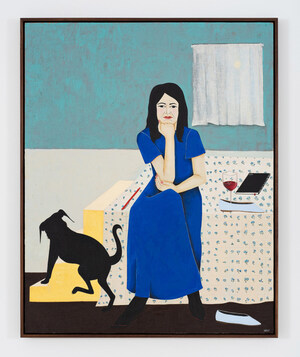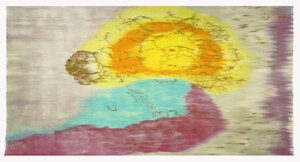Annemarie Schwarzenbach: Departure Without Destination, presented in collaboration with Zentrum Paul Klee in Bern, Switzerland, is the first major retrospective dedicated to the photography of Annemarie Schwarzenbach. The Bechtler Museum of Modern Art will present the U.S. premier of Schwarzenbach's work from April 2 – June 19, 2022. Curated by Martin Waldmeier with the Zentrum Paul Klee, this exhibition features archival material, film, and 200 photographs drawn from the approximately 7,000 photographs in the estate of Annemarie Schwarzenbach, which is held in the Swiss Literary Archives in Bern, Switzerland.
Schwarzenbach was born in 1908 into the affluent Schwarzenbach-Wille family of Zurich industrialists and graduated with degrees in history in Zurich and Paris. Because of her political and sexual orientation, she turned her back on her conservative family and established connections with the German literary diaspora, particularly with the siblings Klaus and Erika Mann. In 1931 she lived in Berlin before moving, after the National Socialist seizure of power, to Spain, Russia and Iran, where she published prose and journalistic writings.
Despite her years-long struggle with drug dependency, over the course of the 1930s, Schwarzenbach professionalized herself as a travel and features journalist. On joint trips with female writers and photographers such as Ella Maillart, Marianne Breslauer and Erika Mann, she turned her attention to social and political subjects, including the rise of National Socialism, the workers' movement in the United States, the consequences of modernization and the role of women in society. Her photographs, though, also reveal a longing for foreign lands and the poetry of travel. Some 300 articles by Schwarzenbach were published in Swiss magazines and newspapers in her lifetime. From 1933 these articles were increasingly accompanied by her own pictures, although most of Schwarzenbach's photographs remained unpublished before her death at the age of 34.
When her literary work was rediscovered in the 1980s, Schwarzenbach became celebrated as a writer, female pioneer and gay icon. Her gender-bending fashion sense and her lifestyle were the inspiration for Clare Waight Keller's Spring/Summer 2019 line for the fashion house Givenchy.
It was not until recently that Schwarzenbach's contributions to photography have been recognized. Her images and writings are closely intertwined and document the upheavals, tensions and conflicts of the period leading up to World War II. Schwarzenbach's photographs also convey private themes, such as life in exile, the search for identity, homosexuality and the desire to transgress conventional gender roles. Above all, though, the photographs express Schwarzenbach's unbridled passion for travel – and her search for encounters with the unknown, the "departure without destination" as an existential experience. The exhibition title 'Departure Without Destination' refers to the life of Annemarie Schwarzenbach, which was characterized by a great restlessness, homelessness, deracination, departure, and a search for hope in foreign countries. These themes run like a thread through her writings and her photographic work and connect the work with the literary tradition of the modern age.
"Annemarie Schwarzenbach was multi-talented – as a writer, journalist and photographer – in a time when few women were represented in these fields," said Bechtler Museum of Modern Art Executive Director Todd D. Smith. "The dialogue that unfolds between Schwarzenbach's texts and photographs opens our eyes to the upheavals and conflicts of the 1930s. At the same time, Schwarzenbach's documentary viewpoint explores themes in a poetic and astonishingly contemporary way."
The exhibition is divided into six chapters featuring Schwarzenbach's work. A Love of Europe addresses Annemarie Schwarzenbach's first years as a photojournalist and her travels through Europe, revealing Schwarzenbach's cosmopolitan attitude. The Happy Valley follows Schwarzenbach's famous car journeys through the Middle East and Central Asia. She made four trips to Turkey, Palestine and Syria, Iraq and Iran, and as far as Afghanistan and India. She wrote her best-known literary work, The Happy Valley, in Iran. Between the Continents features intermediate places such as streets, harbors or ships' decks that become the sites of a temporary community and the settings for farewells and new beginnings. Travels in America deals with her travels in the United States in 1936-1938 where Schwarzenbach engaged intensely with a new understanding of politically committed photography and encountered a society that was still deeply marked by the economic crisis after 1929. Unemployment, poverty droughts, the decline of the cotton industry – her attention is focused on the American system and explores the differences between rich and poor, but also the widespread misery of the African American population in the southern states. The New Earth addresses her ambivalent views on the relationship between nature and culture in the context of mechanization and industrialization. Minor Encounters, tells the story of people she met on her travels and offers a personal view of her circle of friends.
Annemarie Schwarzenbach: Departure Without Destination is supported by the Infusion Fund and its generous donors, as well the City of Charlotte and Foundation for the Carolinas. Additional sponsorship provided by Bellecapital, Brighthouse Financial, and Truist with additional support provided by the North Carolina Arts Council and the Arts and Science Council.
About the Bechtler Museum of Modern Art
The Bechtler Museum of Modern Art is the only museum in the Southern United States exclusively dedicated to European and American Modern Art and its legacies. Capturing a remarkable era of art history from the collection of the Zürich-based Bechtler family, the Bechtler Museum of Modern Art collection includes works by some of the most important and influential figures of modernism, including Alexander Calder, Le Corbusier, Edgar Degas, Max Ernst, Alberto Giacometti, Barbara Hepworth, Jasper Johns, Paul Klee, Alfred Manessier, Joan Miró, Kenneth Noland, Pablo Picasso, Bridget Riley, Nicolas de Staël, Andy Warhol and a wealth of other 20th-century notables. The museum, designed by Swiss architect Mario Botta, prominently features the Niki de Saint Phalle's iconic Le Grand Oiseau de Feu sur l'Arche on its entrance plaza. Located in the heart of Uptown, the Bechtler is a light-filled community space created to inspire and engage first-time visitors and long-term supporters alike.
SOURCE Bechtler Museum of Modern Art








Share this article